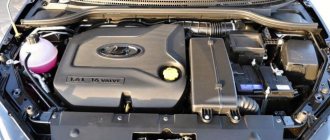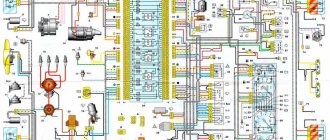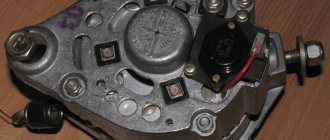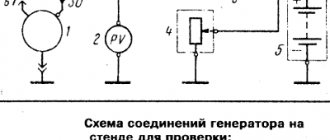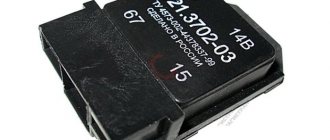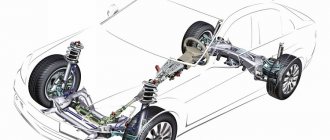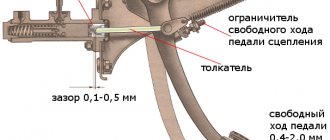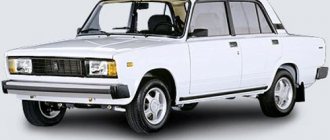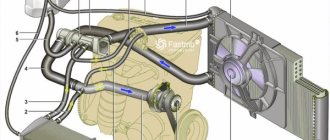“Pyaterochny” engine is an expression that is still in use among owners of old VAZ classics. Some consider this engine quite progressive for its time. Others are harshly critical of him. Where is the truth? As always, she is somewhere in the middle.
It wouldn’t hurt to remind readers of some information about the engine that was installed on the VAZ 2105 - the “tomato box”, as it was called for its rectangular outline.
Design nuances
To obtain the above engine characteristics, the manufacturer carried out experiments:
- piston stroke reduced to 66 mm;
- the cylinder diameter, on the contrary, is increased to 79 mm.
The result was a revving, powerful engine with an aluminum valve cover that absorbed the sounds of the drive. Another feature of the internal combustion engine is the fastening of the timing belt pulley - users do not need to unscrew the bolt on the crankshaft, unlike previous VAZ engine models.
Design 2105
In the operating instructions, the manufacturer recommends which oil to pour into the engine - 5W30 - 15W40.
Some numbers
Two sedans: VAZ 2105, -07 and station wagon -04 represented a new line of VAZ classics, which replaced the “penny” generation (2101, -02, -03, -06). The first-born of this family, the 5th model was equipped with three power units:
| The model of car | Engine index | Volume, cm³ | Power, l. With. |
| VAZ 21051 | -2101 | 1200 | 60 |
| VAZ 2105 | -2105 | 1300 | 64 |
| VAZ 21053 | -2103 | 1500 | 75 |
The 2105 engine was intended as a base engine. The weakest one was not particularly popular. The other two units have their supporters and opponents. Some technical characteristics of the “five” engine:
- The cylinder block is cast iron, unlined.
- The arrangement of 4 cylinders is in-line.
- Boring diameter - 79 mm.
- Piston displacement - 66 mm.
- Power* - 64 l. With. (note - at the beginning of the release the number 68 was indicated). Since there were no structural alterations, this was obviously caused by a change in the determination method.
- Torsion torque - 9.5 kgm at 3400 rpm.
- Volumetric compression - 8.8.
- Gasoline consumption AI-92: city - 10.2; track - 6.2; mixed cycle - 7.9.
What cars were equipped with ICE 2105?
This modernization could not satisfy users of the domestic automobile industry. The main drawback was the regular breakage of the timing belt, AvtoAZ management reduced production volumes, then removed the 2105 engine from production, so only three modifications of the Zhiguli were equipped with the engine:
- 2105 sedan;
- 2104 station wagon;
- 21072 sedan.
Four with engine 2105
Currently, tuning for the engine of this series is not difficult, but among the operating fleet of Zhiguli “fives” with the “native” engine there are very few left.
Design
VAZ-21053 is the progenitor of the “seven”. Externally, it is very similar to the VAZ-2107, with the exception of the radiator grille. It became the first model in which they strongly decided to abandon chrome (in order to reduce the cost of the design). Thus, the radiator grille was completely black, and the shiny moldings usual for the “Classics” were absent on the body. Other differences include new rectangular headlights with integrated turn signals. Also, other bumpers appeared on the “five”. They were also metal, but more voluminous and lacking “fangs”.
The design of the front side windows has also changed. Previously, the Classic had windows. With the advent of the “five”, the door received solid glass. The design of the rear lights has changed. Otherwise, the body structure remains the same. By the way, initially only 13-inch stamped wheels were offered for the Zhiguli. In the 2000s, 14-inch alloy wheels became available for the VAZ-21053.
Among the disadvantages of this car, owners note the quality of corrosion protection. The car is rotting badly. Therefore, it is not surprising that the “five” could be repainted several times. And touch-ups are completely normal for her. The weak points of the “five” are the sills, bottom and arches. There is no protection against corrosion here. In order to somehow protect against rust, the owners themselves coat the bottom with mastic, treat the thresholds with anti-gravel and other means. Plastic fender liners are also often installed on the car.
Pros and cons
Subject to compliance with maintenance and operation regimes, major repairs were not required for the machines for decades. In capable hands, the 2105 engine produced in 1989 is still in use today, and the timing belt life is enough for 40,000 km. If there are no problems with consumables, then the demand for spare parts is not fully satisfied. For example, the cylinder head is always available, and the intake manifolds are welded on site.
Intake manifold
Tuning
It should be said that increasing the power of the VAZ 2105 engine invariably led to a decrease in its service life. For example, after increasing power to 90 horsepower, the average engine life was only 80,000 kilometers before major repairs. That is why the car owner had to decide whether he wanted to increase power, while invariably sacrificing reliability indicators.
- An effective way to tune a 2105 engine is to bore the cylinders to a piston with a diameter of 82 millimeters. Note that such work is a certain complexity, so tuning the VAZ 2105 engine should only be performed by an experienced specialist. At the same time as the cylinders are bored, sports camshafts, a new oil pump and compressor can be installed. In the latter case, the power of the power unit reaches 100 horsepower.
- In extreme versions of VAZ 2105 engine tuning, the engine is replaced with a VAZ 413 rotary engine. The power of this power unit is 140 horsepower. This tuning allows you to increase the maximum speed of the car to 180 kilometers per hour, and acceleration to hundreds takes about 9-10 seconds.
Maintenance regulations
| Maintenance object | Time or mileage (whichever comes first) |
| Timing belt | replacement after 40,000 km |
| Battery | 1 year/20000 |
| Valve clearance | 2 years/20000 |
| Crankcase ventilation | 2 years/20000 |
| Belts that drive attachments | 2 years/20000 |
| Fuel line and tank cap | 2 years/40000 |
| Motor oil | 1 year/10000 |
| Oil filter | 1 year/10000 |
| Air filter | 1 – 2 years/20000 |
| Fuel filter | 4 years/20000 |
| Heating/Cooling Fittings and Hoses | 2 years/40000 |
| Coolant | 2 years/40000 |
| Oxygen sensor | — |
| Spark plug | 1 – 2 years/20000 |
| Exhaust manifold | 2 years |
Knowing what kind of oil is used in the engine and the type of liquid with which the cooling system is filled, you can carry out maintenance of the “five” internal combustion engine yourself.
VAZ-21053: dimensions, ground clearance
By European standards, the car belongs to the B-class. Thus, the total length of the body is 4.13 meters, width – 1.62, height – 1.45 meters. But it must be said that the length of the wheelbase (2424 millimeters) is very modest even for the B-class. At the same time, the car has impressive ground clearance. On standard 13-inch wheels its size is 17 centimeters. Some owners even raise the rear end. But basically this is not done for cross-country ability (after all, even with standard ground clearance the vehicle could confidently “force” the dirt road), but with the aim of increasing the load capacity. The suspension was very soft and when heavily loaded the rear part sagged a lot.
Causes of malfunctions and their elimination
In principle, the 2105 engine has all the typical malfunctions of carburetor in-line internal combustion engines:
- clogging of the fuel system, fuel pump, carburetor, throttle, jets and filter;
- exhaustion of the life of the air filter and microswitch;
- failure of the ignition system and stuck valves and piston rings;
- breakdown of gaskets and seals, misadjustment of cam gaps;
- production of cylinders/pistons, bearing shells;
- loosening the flywheel bolts and attachment drive belts.
But the engine diagram allows you to avoid major repairs if the timing belt breaks by 100%.
Salon
Inside, the car looks the same as the “four” and “seven”. The driver has a four-spoke steering wheel without any adjustment and a flat fabric seat. The instrument panel on the VAZ-21053 is a pointer panel with modest backlighting. Nevertheless, everything necessary was located here: speedometer, tachometer, fuel level and antifreeze temperature sensor.
By the way, the “five” became the first car among the “Classics”, which was standardly equipped with a heated rear window. In addition, the front door windows have been ventilated in the cabin. However, in order to place deflectors in the panel, it was necessary to reduce the already small-sized glove compartment. The interior here is so simple that the only electronic items are interior lighting and rear window heating. All window regulators are mechanical. The seats are manually adjustable. Among the shortcomings in the interior, the owners note:
- Poor sound insulation. It is very noisy inside, especially at speed, when the roar of the engine can be heard from under the hood.
- Uncomfortable seats. Although they received height-adjustable headrests, they were extremely uncomfortable. There was no lumbar and lateral support. In addition, the seats quickly sank and rubbed. Because of this, you could often see covers on the seats of Zhiguli cars.
- Bad ergonomics. In particular, this concerned the steering wheel and inconvenient controls on the stove.
We recommend: Spark plugs for Priora for a 16-valve engine, manufacturers and prices of analogues
Recycling program
The car was not in demand, and the manufacturer had already begun to suffer losses. The situation was smoothed out after the introduction of a recycling program, when the owner of an old car received 50,000 rubles from the state as compensation for melting it down. During this period, all AvtoVAZ models, including the VAZ-21053, again became in demand. Prices rose, and then a balancing act began between the cost of the scrappage certificate and the market value of the car. This continued until the model was removed from the assembly line (2009).
We recommend: German ZF gearboxes on KAMAZ trucks
Why did the car attract buyers, albeit few? First of all, the availability of spare parts and components, which were relatively inexpensive. In addition, the attractiveness of the VAZ-21053 for Russians was the possibility of repairing and servicing it on their own (in the garage, on the site, or simply “in the field”). This circumstance somewhat leveled out the low demand for the car, but its prestige on the world market fell hopelessly. The car was no longer equipped with even the most necessary accessories; it got to the point that at the beginning of 2009, the daily mileage counter was removed from the dashboard.
Chassis of the “five”
It is almost similar to other classic VAZ models. Thus, an independent spring suspension with transverse swing arms was installed on the front of the car. There is also a stabilizer bar at the front. At the rear there is a spring dependent suspension with longitudinal and transverse bars. The brake system is hydraulic, dual-circuit, with a vacuum booster. Disc brakes are installed at the front, drum brakes at the rear. The handbrake is mechanical, with drive to the rear wheels.
As reviews note, the suspension on the “five” is very soft. It is able to dampen vibrations even at high speeds. But at the same time, the suspension did not tolerate sharp impacts. Due to breakdowns, owners were faced with deformation of the axles of the lower arms. Also, due to the excessively soft suspension, the car took turns poorly and was practically uncontrollable at high speeds. Reviews include all hinge joints as weak points in the chassis. These are steering rods and ball joints. The shock absorbers quickly became unusable due to the large suspension travel. Also, due to low-grade metal, wheel bearings have to be replaced frequently.
DIY repair
If you want to overhaul the engine yourself, pay special attention to the marks, which are needed even for ordinary simple operations, such as adjusting valves. Marks also allow you to correctly install certain parts and components. A diagram or a detailed video, which you will find at the end of the article, will help you in your work. Regardless of the simple device, the VAZ 21053 engine must be assembled as accurately as possible. Of course, the engine should be repaired on a clean workbench so that particles that accelerate wear do not penetrate inside.
Remember that in some cases the markings are applied to the parts incorrectly, so even if the marks are compared, unstable operation of the unit may be observed. In this case, the part should be replaced or contacted by specialists with high-quality diagnostic equipment. You can always consult with experienced owners of VAZ 21053 cars, who should know the structure and features of repair work.
Sources
- https://www.syl.ru/article/398875/vaz—foto-i-opisanie-tehnicheskie-harakteristiki-tyuning
- https://Driving24.ru/tyuning-i-kapitalnyj-remont-dvigatelya-vaz-21053-chto-vybrat/
- https://pochiniavto.ru/vaz/21053/
- https://FB.ru/article/154809/vaz—tehnicheskie-harakteristiki-otzyivyi-foto-tsenyi


